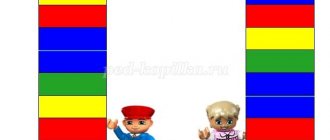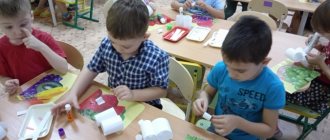Preview:
SUMMARY OF NODES FOR CONSTRUCTION FROM WASTE MATERIAL
IN THE SENIOR GROUP
V-l: Nikitina M.Yu.
Car construction diagram:
SUMMARY OF NODES FOR CONSTRUCTION FROM WASTE MATERIAL
IN THE SENIOR GROUP
– Expand ideas about machines and their importance in human life.
– Introduce children to construction techniques from waste material (matchboxes).
– Creating conditions for the development of research skills in children.
– Learn to analyze your activities.
– Learn to create transport models according to the diagram.
– Consolidate knowledge of traffic rules.
– Develop attention, memory, thinking, creative imagination
– To develop children’s interest in design.
– Ability to work from a drawing.
– Develop the ability and desire to see things through to completion.
– Cultivate friendly relationships between children.
Demonstration: Slides depicting various types of passenger transport, car models.
Handout: Matchboxes, PVA glue, brushes, napkins, scissors, colored paper, stickers, car craft diagram.
Riddles about transport, looking at slides, pictures, talking with children, watching videos on assembling cars.
The children are offered drawings that depict the sequence of constructing passenger cars from matchboxes. Children look at the drawings, analyze the design and select the necessary material for constructing the transport, and sit down to do the work. Teacher helps struggling children with advice
MANUFACTURING A PASSENGER CAR MODEL:
– gluing a truck body (from matchboxes)
– glue the body to the cab
– cut and glue the wheels
The guys brought us a telegram today - (reads)
“Thank you for the trucks you made for us. But we need your help again. We will soon have a car rally. Please help us and make us cars.
Educator: - Well, guys, can we help? (Yes)
But first we will prepare our fingers for work.
Finger gymnastics “Transport”
Cars are walking along the highway (turn an imaginary steering wheel.)
Tires are rolling on the asphalt. (elbows pressed to the body, palms moving parallel to each other).
Don’t run along the road, (they shook a finger.)
I'll tell you: "Beep." (hand clenched into a fist, thumb straightened - “signal”)
Educator: Today I again invite you to make cars from matchboxes.
The following is a verbal instruction from the teacher regarding the sequence of work:
1. We cover the matchboxes with colored paper.
2. Glue two matchboxes, then glue the third one on top.
(fixed by hand for better gluing of parts).
3. We glue windows, wheels, and headlights from ready-made blanks.
We wait until the glue dries and all the parts are securely fastened.
Children work at tables. Individual work with children experiencing difficulties.
Educator: - I see that many of you have already made cars.
You can go to a rally. Whoever arrives at the finish line first will receive a prize.
Let's send them to the parking lot and clean up their work areas (putting away glue, napkins, remaining paper on their trays).
Acting out: the cars go to the parking lot, the children talk about the cars they made and their purpose.
Educator: - Well, guys, you all worked hard today. What good deed have you done? (children's answers).
Educator: - Did you like making a passenger car?
Paper origami machines (diagrams)
Origami racing car
Such cars were popular in the USSR. We also post a video:
Origami tank
Origami machine
Watering machine with LEGO WeDo
Abstract of the GCD within the framework of the project “Machines in Agriculture” for children of the preparatory group.
The educational robotics platform LEGO Education WeDo promotes children's knowledge of the world around them by creating and “bringing to life” with the help of software different designs made on the basis of LEGO System . The LEGO WeDo software environment is graphical and uses a child-friendly drag-and-drop programming format. Creating a model with LEGO WeDo is always an integrated project
various educational areas: collecting information on its topic, finding solutions to problems in communicating with peers and adults, design, programming, research, which corresponds to the Federal State Educational Standard for Education.
GCD "Water-watering machine"
Target
adult: create conditions for the development of children’s creative and technical abilities in the process of constructing a model of the “Water-watering can” sprinkler.
Target
children's: learn how to build structures using LEGO WeDo.
Training tasks:
consolidate ideas about agricultural work and the technology that makes it easier, skills in creating programs for the functioning of LEGO WeDo models; enrich your vocabulary.
Developmental tasks:
develop visual and auditory attention, memory, thinking, programming skills.
Educational tasks:
develop a friendly attitude towards peers, the ability to work in a team and effectively distribute responsibilities; respect for nature.
Preliminary work:
watching videos about agriculture, illustrations of agricultural production techniques; conversations about problems in the work of people in agricultural professions; role-playing game “Design Bureau”; design of agricultural machines.
Equipment:
laptop, projector, interactive whiteboard, LEGO WeDo constructor.
Demo material:
animal figures, improvised field; 2 watering cans, 2 containers with soil.
Handout:
“passes” of yellow and green color on an adhesive base; task cards.
Progress of activities
(The teacher calls the children and gives them passes that are attached to their clothes. Yellow passes are given to preschoolers with developed design skills who are able to complete tasks more complex than the basic level. The teacher gives green passes to children with less developed design skills, they will be offered basic level tasks.)
Teacher
: Welcome to the Design Bureau!
(Suddenly, a sound file with a message about an email is turned on, which can be deciphered and opened by completing a game task. The teacher starts the “Match the Pairs” game. The puzzles that open on the screen are automatically folded into a picture depicting corn plants with yellowed leaves and stems. After this, it opens letter, the teacher reads it.)
Teacher
: Great, you put everything in the right place! Children's science scientist Znayka is writing to you. The summer was warm, sunny, hot and dry, very pleasant for children, but completely joyless for plants. In the kindergarten area, this problem can be easily corrected with the help of a watering can. How can we help potatoes, wheat, cabbage in the fields? Do people really have to walk through huge fields with watering cans? Look what happened to the plants. Maybe you can help them? Will one watering can be enough for a large field? How you can help
plants?
(The teacher, with the help of leading questions and explanations, leads the children to assimilate information and resolve the problem situation.)
Children:
You can make a car that will drive across the field and water the plants. It will be able to carry a lot of water. Many plants will be watered at once.
Teacher
: Well done boys!
Look at your pass and take a seat at a table of the same color. (Children are divided into two subgroups. The teacher distributes cards with tasks from the LearningApps.org program.)
For everyone at the yellow table, the task is “Remove the extra one”;
at the green table - the task “What does it look like?” (Children complete tasks.)
Teacher
: You have completed your job successfully.
Here is the second task: yellow table, do you have any “extra details” left? Connect them to form a worm gear mechanism. Invent and build a machine that will work using this mechanism. Green table, build a watering system using the parts shown on the card. What will happen instead of a water pipe? Instead of a wheel? Instead of an injector? (Children name the parts: beam, pulley, round brick.)
Why is the round brick more like a nozzle?
Children:
The protrusions on it are similar to the nozzle holes.
Teacher
: Let's do an experiment.
We will pour the soil in one container from a watering can with a nozzle, and in the other - from a watering can without a nozzle. I wonder which watering can will water the most land? (Children water the ground and conclude: a round brick is suitable for the structure.)
Scientist Znayka sent us a letter again. Let's see what's in it. (The teacher shows a video of Znayka’s friends dancing.)
And you and I will dance with them.
( Exercise with robots. Children follow the robots.)
Teacher
: We just have to connect two parts - the machine and the irrigation installation.
(Children connect parts of the structure, use additional parts if necessary.)
Now let’s check how the watering machine works. What needs to be done to make the car move?
Children:
You need to write a program.
(Preschoolers offer options for the program, compose it and check how the machine works.)
Teacher
: Imagine that animals approached a canal with water.
They want to get drunk, but there is no person in the car! Can you make sure that when an obstacle is detected, the watering machine will stop itself? (Children discuss the problem and propose adding a distance sensor to the design, reflect it in the program, then check their guesses.)
Teacher
: Well done, you completed Znayka’s task and helped save the harvest!
Now you can play with this design. (Children are playing.)
Anastasia Kharlamova, teacher
at MBDOU Igrinsky kindergarten No. 10 village. Game, Udmurt Republic
Creative machines - paper crafts (full instructions)
We accumulate quite a lot of tubes after using toilet paper. And if we used to throw them away, now we decided to make crafts out of them. The results were such wonderful machines. Do you want the same? Let's get started!
We will need:
- Scissors or knife
- Glue
- Brush
- Toilet paper tubes
- Acrylic paints
- Cardboard
- White and colored paper (for decoration)
- Small nails or buttons
- Pencil





